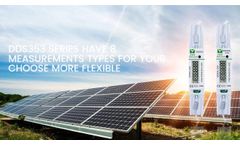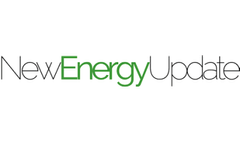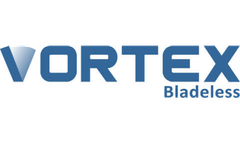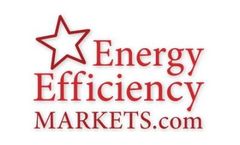Wind Power Integration Into Electricity Systems Articles & Analysis
35 articles found
An export electricity meter is a device used to measure and record the output energy in a power system, usually used in solar power generation systems, wind power generation systems or other renewable energy generation systems. With the vigorous ...
Firm renewables enable us to reliably meet energy demand regardless of varied weather conditions, which can pose issues for solutions like wind and solar. Mass adoption of solutions like hydroelectric power, which uses the natural flow of moving water to generate electricity, or biogas, which takes raw materials like municipal waste and manure ...
Introducing the next generation of SimpliPhi Power’s industry-leading safe lithium ferro phosphate (LFP) battery – the PHI 3.8-M – now available in our sleek but tough signature white metal design. Instantly recognizable by the rugged, powder-coated steel housing, our updated PHI 3.8-M kilowatt-hour (kWh) battery is more durable, efficient, and capable of withstanding the ...
Germany's Siemens Gamesa will supply 11 of its 8 MW direct drive turbines while Norway's Kvaerner will design and build the substructures and lead onshore assembly, inshore marine operations and site connection. UK group JDR Cable Systems will supply the electrical cables and Norway's Subsea 7 will install the cables and connect up the wind ...
1.Introduction Living off the grid brings memories of a cabin deep in the woods or a hut in the mountains. But in essence, off grid solar system is basically home solar systems providing electricity to private premises and not necessarily in connection with the public grid. Living off the grid is a state of autonomy. It is a way to avoid all the complications that come with sharing electricity ...
With their considerable height and large blades turning almost hypnotically, wind turbines have become an iconic symbol of the planet's shift to renewable sources of energy. In Spain, however, one business is looking to design wind generators that produce renewable energy without blades. "Our goal is to develop a new wind generator that minimize(s) the amount of mechanical elements to reduce ...
This paper presents the development and qualitative validation of a doubly-fed induction generator (DFIG) wind turbine model that is represented in terms of behaviour equations of each of the subsystems, mainly the turbine rotor, the drive train, the induction generator, the power converters and associated control systems and a protection system. Simulation results obtained from the models are ...
In this paper, data–driven system modelling, control, and fault detection technique for wind turbine systems are researched. The developed algorithm is to recursively update system parameters using predictor–based system identification (SID) technique. Updated system parameters are used to design subspace predictive controller for wind turbine systems with constraint on pitch angle and generator ...
The impact of the wind generation on the power systems is no longer negligible if high penetration levels are going to be achieved. It is very important to boost the transfer capability of the transmission system while improving the utilisation of transmission assets to accommodate high penetration of wind power on the network. Hence, more sophisticated control schemes using advanced power ...
The efficiency of the wind power conversions systems can be greatly improved using an appropriate control algorithm. In this work, a robust control for variable speed wind power generation that incorporates a doubly feed induction generator is described. The electrical systems incorporate a wound rotor induction machine with back–to–back three phase power converter bridges between its rotor and ...
This paper presents a voltage and frequency controller with neutral current compensation in a stand alone wind energy conversion system (WECS) employing an asynchronous generator. The proposed controller consists of a three leg insulated gate bipolar junction transistor (IGBT)–based voltage source converter and a battery energy storage system (BESS) at its DC bus. The neutral terminal for the ...
In this study, the solar radiation and wind data pertaining to Bigadic region are analyzed to assess the performance of a hybrid Photovoltaic–Wind–Diesel–Battery energy system. The average energy consumption of the system is about 20.33 kWh per day and 600 kWh per month, with a peak power demand of 2.4 kW. A 10 kW Wind Turbine and a 1 kWp PV energy system with 48 kW battery are installed. The ...
In this study, the solar radiation and wind data pertaining to Bigadic region are analyzed to assess the performance of a hybrid Photovoltaic-Wind-Diesel-Battery energy system. The average energy consumption of the system is about 20.33 kWh per day and 600 kWh per month, with a peak power demand of 2.4 kW. A 10 kW Wind Turbine and a 1 kWp PV energy system with 48 kW battery are installed. The ...
In this paper, a new robust controller has been proposed for attaining the maximum safe instantaneous wind penetration. Particle swarm optimisation (PSO)-based algorithm has been developed to obtain the maximum safe instantaneous penetration by the optimisation of grid parameters. The developed algorithm has been tested on modified IEEE 14-bus system. The effectiveness of the proposed methodology ...
This paper analyses the development of wind power in The Netherlands and Denmark in the period 1973-2000 with the cyclic innovation model (CIM). CIM regards innovation as a cyclic process in which different actors constantly develop and exchange knowledge through four different types of cycles: hard science cycle, soft science cycle, integrated engineering cycle, and differentiated valorisation ...
This paper investigates the operation and control of multiple Distributed Generation (DG) systems interconnected to the utility in the form of microgrid. The developed model of the microgrid consists of microturbine generation system, converter-based DG system with stiff DC source, synchronous-generator-based DG system and wind power system with induction generator. The Simulation model of the ...
This paper presents a novel usage of 6/3-phase dual stator-winding induction generator (DWIG) with a static excitation power controller (SEC) as a wind power generator. This generator is composed of a standard squirrel-cage rotor and two sets of winding housed in the stator slots. One is referred to as the 6-phase power winding, and the other is defined as the 3-phase control winding. On the ...
Hust says she is particularly eager to see how the tax credit affects manufacturing of advanced transmission, smart grid and energy storage products, since they may be key to integrating more wind power into the system. The DOE says the credit is available for:• Technologies that create energy from renewable resources (sun, ...
In this paper, a methodology for sizing of hybrid photovoltaic-wind power generation (HPVWPG) system is described. The purpose of this methodology is to predict the PV-generator area, the capacity of the battery and the capacity of the wind generator in isolated (remote) areas, where the meteorological data (solar irradiation, air temperature, wind speed, etc) are not always available. For this ...
Currently, wind power faces heterogeneous conditions for market integration throughout Europe, given both differing wind power and power system characteristics as well as according regulatory frameworks. This paper discusses marketing options and assesses the influence of market ...








